‘A useful extreme’
Wendy Burk's representation of human-plant communication

Recent ecopoetics has demonstrated considerable interest in what Joan Retallack speaks of as “reinvestigat[ing] our species’ relation to other inhabitants of the fragile and finite territory our species named, claimed, exploited, sentimentalized, and aggrandized as ‘our world.’”[1] Increasingly, poets have been concerned with exploring and transforming human relations to plant and animal life, while resisting human exceptionalism and attempting to escape or minimize anthropocentrism; their practice aligns with posthumanist investigations across the environmental humanities into the manifestations among more-than-human beings of powers of mind and consciousness once thought to be distinctively human. Poets interested in rethinking human relations to vegetal life in particular have found support in botanical sciences’ increasing attention to plant communication — e.g., to the biochemical signals with which plants evade predators, attract pollinators, or communicate danger to other plants — and, within the field controversially dubbed by some botanical neurobiology or plant neurobiology, to plant intelligence.[2] Increasing scientific information does not, however, reduce the formal, generic, and ethical challenges of producing poetry (to quote Retallack again) “acting in an interrogative mode that attempts to invite extra-textual experience into the poetics somehow on its terms.”[3] In Tree Talks, Southern Arizona, Wendy Burk has devised a striking way to explore these challenges: she records her own attempt to treat actual trees as if they possess powers of cognition, memory, and feeling at least analogous to those of humans by approaching individual trees as subjects of ethnographic investigation.[4]
Literally based in interrogative procedures, Burk’s volume consists of chronologically arranged “unstructured interviews” she conducted with eight trees of different species representing diverse ecological communities of southeastern Arizona, where she lives. For each of her tree subjects, she posed questions out loud in English and after each question produced a transcription of the movements and sounds she detected in the tree as well as those she registered from birds, insects, animals, cars, machines, and sometimes human beings at the scene. Each interview is followed by a photograph of the tree, while the volume’s appendix contains succinct descriptions of each tree and its surroundings — nearby plants, geographical features, or man-made structures, weather conditions at the time of the interview, etc. Burk identifies herself as the “investigator” and, following social-science interview conventions, explains her methodology, plots the location of her tree subjects, and records the dates and times of each interview,[5] though we might note the absence of the consent procedures that would be required to obtain IRB (Institutional Review Board) approval for such work with human subjects.[6] In her highly visual transcriptions, which she regards as poetry,[7] Burk uses descending page space to record the sounds and movements over time of the multiple entities displayed to the right and left of the tree subject, “S,” whose movements are registered down the center of the page. Employing varying font size to convey differences in volume, the transcriptions sometimes employ conventional representations of noises made by familiar birds, mammals, cars, or wind, identified in bracketed italics — e.g., “hooooo” for wind or for an owl, “yipyipyipyipi i i i” for coyotes. More often the alphabetic representations are carefully unfamiliar — ducks call “qrk,” unspecified birds call “teent” or “heer!,” dogs bark “work work,” a cow bawls “MRRRNNNNN!” Diacritical marks constitute much of the text, recording the tree subjects as well as flying insects, bells, music, a bicycle, machines, and more.
The book’s blurbers are themselves respected ecopoets, and all three, to varying degrees, claim that what Burk achieves is transspecies communication. Brenda Iijima sees “a poetic dialogue with trees … as living presences in direct exchange across the divide of species and genera.” Regarding the interview poems as “exchanges,” she enthuses, “What does it mean when a human-animal reaches out to a tree in open conversation and attunes to the complexities of disclosure and transmission. The ensuing record is effervescent — an expanse of mutual curiosity.” While the other two blurbers don’t make claims for “dialogue,” “exchange,” or “mutual[ity],” they, too, seem to regard the poems as opening spaces for humans to understand or hear trees as if the divisions between human and tree may be transcended. Eleni Sikelianos’s comment ends, “In a world cluttered with language, these poems clear a listening space, free of borders, where we can tune in to the urgent unspoken,” while Craig Santos Perez’s blurb concludes, “In our era of global deforestation, this book is a timely and profound reminder that we must talk to trees and listen, deeply, to their sentience.”
Burk’s own comments, however, suggest quite different aims and achievements. Far from suggesting that her procedures have erased boundaries between trees and humans and allowed us to register trees’ silent language, she announces at the close of the book’s brief introduction that she’s exploring and performing a process of domination typical of what Western humans do when we desire to know an other:
I came to this study as a way to consider ethics, environment, politics, communication, and failure to communicate. In carrying out the work, I asked myself how the underlying privileges and assumptions of my writing are complicit with the dominant culture’s drive to dominate, through warfare, science, or art. The poems in Tree Talks: Southern Arizona take those assumptions to what I hope is a useful extreme.[8]
Her poems do not suggest any deliberate plant signaling that humans can comprehend, however attentively one may listen; the diacritic marks of her tree subjects remain entirely inscrutable. She told an interviewer, “In one sense the tree talks appear on the page like visual representations of soundscapes, moving vertically through time and horizontally through space. In another sense they are like conversations at cross-purposes or maybe even interrogations, raising questions about the ethics and assumptions of questions themselves.”[9] She has also characterized the texts as “records of how communication fails, even when we would very much like it to succeed.”[10] As I understand the project, Burk remains convinced that what the feminist environmental philosopher Val Plumwood discusses as our “epistemic locatedness” keeps human representation and comprehension of the vegetal other restricted within notably human terms. But Plumwood distinguishes anthropocentrism, which she sees as a moral failing as avoidable as racism, sexism, or Eurocentrism, from an inescapable “human epistemic locatedness” that need not limit ethical concern to the self.[11] Similarly, Burk, even as she illustrates how far humans — at least in Western cultures — are from being able to talk with trees, presents readers with transcriptions that help us see more clearly the environment we share with trees. From her investigations we may in fact learn a good deal about our environment, about ourselves, about ethical relations to trees, and indeed about trees themselves.
Without preaching, the “visual representations of soundscapes” in Tree Talks: Southern Arizona demonstrate the omnipresent environmental impacts of industrialized humankind. Burk calls readers’ attention to human alterations of the biosphere from the outset via the book’s cover photo, a section of bark on the trunk of the Eucalyptus in a Tucson park that is Burk’s fifth interview subject.
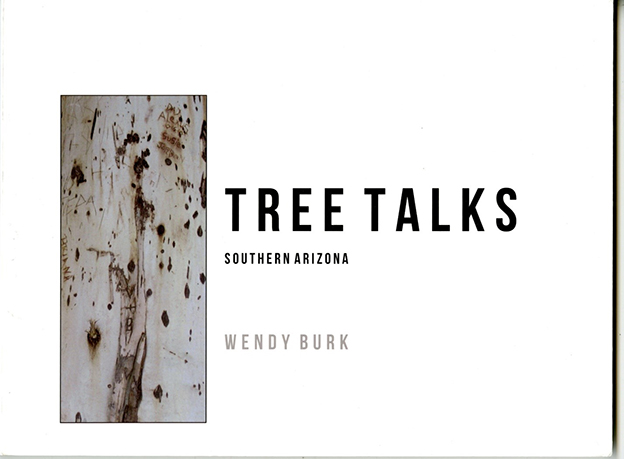
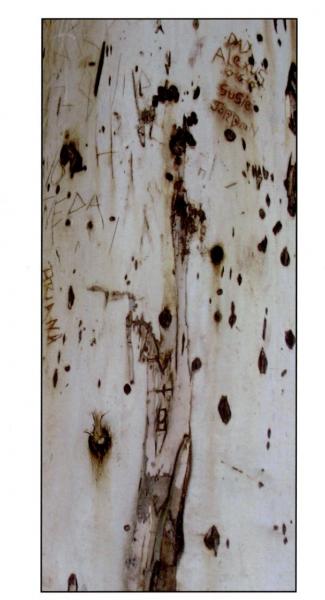
The close-up displays multiple human carvings so that what the tree most evidently “says” here is “Briana,” “Alexus,” “Susie,” “Jordan,” and “Hi.” It “talks” the human names and words people have inscribed on it. That such inscription is harmful seems underscored by a set of initials, a descending “V + B” carved into a wound in the bark. By simply looking at the tree’s surface, we apprehend more-than-human nature altered and damaged by dominating human hands.
It is significant that the tree subjects whose motions are recorded as delicate diacritical marks are never recorded as solitary individuals. Presumably, Burk’s interviewing of single trees respectfully signals that a tree is as interesting in itself as a human being. However, trees do not thrive as isolated individuals. Science increasingly reveals that trees are crucially linked to one another via extensive mycorrhizal networks through which they trade carbon and exchange nutrients. While not representing subterranean bonds unregistered in the soundscape, Burk’s format nonetheless insists that a tree exists as part of an ecosystem, for along with the sounds and motions of the tree, she records birds, insects, and domesticated as well as wild animals; the responses to her questions, if read as such, come from an array of intertwined lives, some of which may depend on the tree for food and habitat.
From the visual choreography of her pages comes more than a recognition of ecosystemic interdependence; readers also see the omnipresent impact of humans. While the interviewed trees occupy varied locations, different ecosystems, and distinctive soundscapes with varying levels of registered biodiversity, only one of the talks is free from sounds produced directly by humans, usually airplanes and car engines. Even the interview recorded in the Coronado National Forest registers a plane overhead. The interview containing no man-made machines or human voices, which was recorded in the Chiricahua Mountains, “a short walk” (72) from that same National Forest, includes the hoofbeats of a cow and calf — evidence of human land management. Significantly, the very process of Burk’s interview with a Blue Palo Verde tree planted in the strip between the sidewalk and a Tucson street itself enhances Burk’s awareness of anthropogenic noise pollution. An air handler in a building nearby runs during the entire interview — recorded as a vertical line of alternating capital Z’s and asterisks along the left-hand margin — and prompts Burk to say: “I never imagined the air handler was this loud. Did it bother you when they put the building in? Does it bother you now?” (55). Where the tree’s response might appear, a bee meanders instead:

As always, there are no intelligible arboreal responses to Burk’s questions. Yet the attention involved in the interview has altered the “investigator’s” awareness. Following suit, we readers may be better attuned to the ways in which developments we regard as improving our quality of life may adversely affect other species. Humans may be particularly insensitive to the impact our way of life has on plants, since plants can’t show aversion by uprooting themselves and seeking alternative habitat. We may remain comfortably oblivious even to deadly human behavior, as trees generally do not, by human standards, die quickly.
The questions Burk poses reflect a desire to better understand her arboreal subjects. In the first interview, for instance, most of the questions take the form of “tell me about your experience of x” — “x” being perhaps “time here” (5) or “clouds and weather” (6) or “standing still surrounded by moving water” in a flood (8). The response of the Fremont Cottonwood tree to the question about its experience of time is a vertical line of irregularly spaced commas and slash marks, to the question about clouds and weather a bracketed ellipsis, and to the question about standing in flood waters several slightly diagonal arrays of descending backslashes.
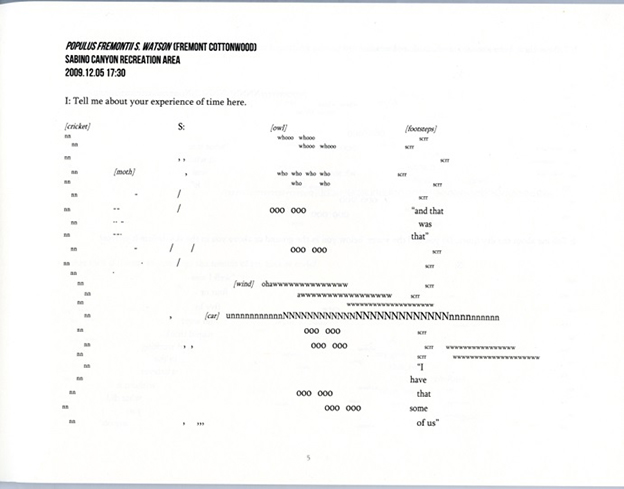
It seems to me crucial to acknowledge that these responses — like all the diacritical marks in which sounds or movements of the trees are recorded — remain unintelligible; the reader gleans from them no information that addresses the questions posed. Yet, from an environmentally conscious standpoint, the mere act of posing such questions has the virtue of inviting readers to think more about what happens to trees as possibly sentient forms of life in a constantly changing environment. Sometimes Burk’s questions valuably acknowledge that tree experience differs from that of humans, at least in its mechanisms. For instance, Burk prompts, “Tell me about your experience of people. Do you hear them passing by on the road and, if so, with what part of you do you hear them?” (7). But despite registering awareness of species difference, those questions problematically ask for a kind of communication — telling — and a kind of perception — hearing — that flatly anthropomorphizes and elides the chemical signaling through which trees may in fact communicate with plants and insects in their environment.
Discomforting anthropomorphism is more blatant in questions from later interviews that inquire into the tree subjects’ feelings, preferences, and dreams, even asking about specific emotions. For instance, Burk asks the Eucalyptus, member of a species introduced to this continent by Australians during the California Gold Rush, “Do you resent being brought here?” (43). The effect in that case is complicated: even while the question suggests a disturbing imposition on vegetal being of human norms, the passive voice in “being brought” may serve to remind readers that derogatively labeled “invasive exotic” plants did not chose to relocate and disturb native ecosystems; they did so through human agency.[12] We may even be invited to ponder possible analogies between the transportation of plants and the transportation of humans “brought here,” whether Africans brought to this continent as slaves or Asian men brought not long after the Gold Rush to build railroads. I am not suggesting that Burk equates the trauma inflicted on oppressed or enslaved humans with that inflicted on transplanted vegetation; rather, her phrasing invites us to consider how the two result from similar logics of domination and control. The passage may point to shared ideological roots of social injustice and environmental degradation.
That even anthropocentric (or at least epistemically located) questions may generate fruitfully complicated insights is demonstrated with particular clarity in Burk’s interview with the One-Seed Juniper in a spot overlooking Portal Peak, east of Portal, Arizona, and sixty miles from the US/Mexico border.
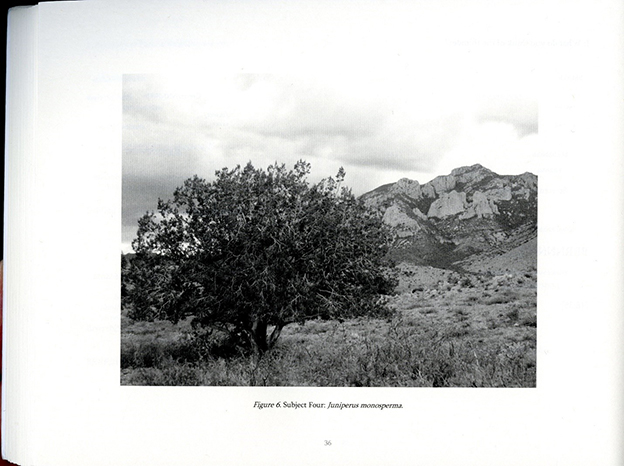
Burk says, “We often read in the paper that this is a dangerous place, and getting more dangerous yearly. Does that have a meaning for you? Does danger have a meaning for you?” (33). The tree grows in an area of the Chiricahua Mountains that has come to be heavily used by drug traffickers and is the terrain of drug cartel turf wars. Particular segments of human society, including local landowners, have defined this as a dangerous place because of its threats to themselves and their property. The text that follows Burk’s questions about danger shows from her juniper subject a vertical array of mostly clustered open parentheses. Transcribed sounds of a cow (“clp”) and a calf (“clk”) are seen moving across the text, along with a good deal of thunder and wind.
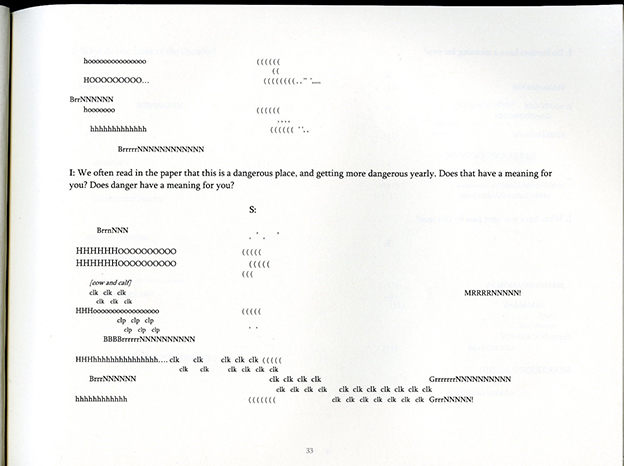
The tree subject’s response and the meanings of the ensemble’s soundscape remain cryptic, but Burk’s questions prove resonant. We know that forests and trees can be endangered by many things — diseases, insect pests, extreme drought, human developers or lumber companies, warming climate, wildfires, etc. — yet science, conducting its own versions of experimental interviews, is only beginning to learn about the resources plants possess to respond to threats via cellular changes, chemical signaling, and associations with mycorrhizal fungi. Burk’s questions underscore human ignorance and limitation. Moments later she asks, “Do borders have a meaning for you?” (34), recording in response a handful of spaced commas and four clusters of open parentheses from S, accompanied by the sounds of cattle’s hooves, some thunder, and considerable wind.
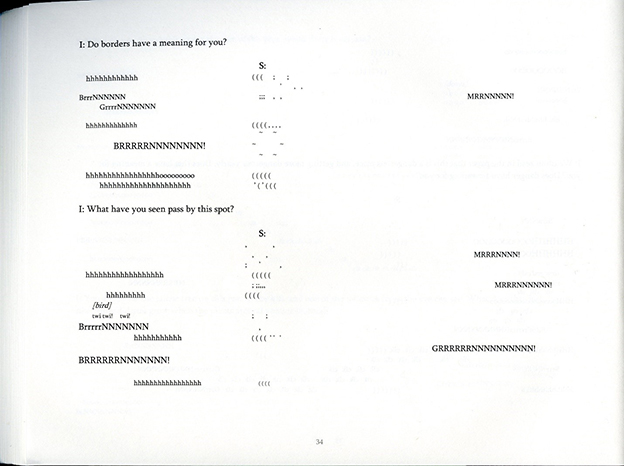
This score of sound and motion reveals nothing out of the ordinary, but the question calls our attention to a morass of political issues around the establishment of borders that, even while they have no meaning for more-than-human beings, can have huge impacts on them. To invoke an infamous example that postdates Burk’s talks, Trump’s border wall that has bifurcated a vast landscape has been an environmental disaster, putting at risk habitats of dozens of endangered species and fragmenting their populations; limiting the ability of wildlife to seek food and water, locate mates, or escape from fires; disrupting seasonal migrations that also impact plant regeneration; increasing erosion and exacerbating the impact of floods; etc.
Burk’s title Tree Talks is ambiguous: she might be conveying trees’ thoughts in Tree Talks rather than, say, TED Talks, or she might be presenting conversations with trees. Either interpretation conveys a desire to dignify trees by treating them as beings who have things to say to humans and with whom humans might communicate. In this context, it’s useful to consider Michael Pollan’s proposal in his lively article “The Intelligent Plant”: “One way to exalt plants is by demonstrating their animal-like capabilities. But another way is to focus on all the things plants can do that we cannot.”[13] Burk’s interviews in Tree Talks seem to attempt the former course, treating trees as one would human ethnographic subjects, but they enact its critique. The impulse to read her procedures too earnestly might fruitfully be countered by understanding the book as fitting the literary genre of the fake interview — the imagined interview that’s usually conducted with a deceased writer (as in Bob Perelman’s “A False Account of Talking with Frank O’Hara and Roland Barthes in Philadelphia”) or sometimes with a part of oneself (as in Retallack’s interview with Quinta Slef in “The Poethical Wager”). Rather than recording a real conversation, fake interviews register a desired exchange while they stage the exposition of varied points of view generated within one writer’s mind. They may well be send-ups of the very genre they purport to be, implicitly challenging a common methodology of knowledge production — as Burk may be challenging the interrogative procedures of (usually colonialist) ethnography. Like many of us who care about the green world of our environment, Burk longs to talk with trees; that is her interview fantasy. She knows, however, that she can only talk to them, and uses her version of the fake interview to expose the ethical pitfalls and practical limitations of attempting to talk with and listen to trees when tree language and intelligence, if we may use those terms, take place through mechanisms markedly different from the human-animal brain and nervous system. What we might imagine as allowing the plant due dignity by inviting its speech is revealed as likely to be only an imposition of our own all-too-human behaviors and perceptions.
Yet — to return to Pollan’s proposal — even as the partially stereotyped character of Burk’s alphabetic transcriptions and the elusive nature of her diacritical signs enforce their inadequacy as translation, the visual artfulness of her pages does exalt trees and other more-than-human beings through their difference from us. Burk does not claim the ability to specify those differences, but her abstract page designs open windows onto them. We experience through our eyes the scalar contrast between the marks registering the tree’s limited motion and the larger letters conveying the racket of ducks, cars, people’s parties, or an air handler. We see the weave of the elements in the soundscape, and the delicacy of the contributions made by trees, which alone among the entities recorded are by their nature both silent and fixed in place. Their distinctiveness is striking. Burk’s typographic scores, tracking multiple beings moving through landscapes in which trees are rooted, offer maps of each site as a dance of bodies and sounds, some of which overpower each other, each of which is available to the focused observer. These quite beautiful designs are unmistakably a human creation and depend on decisions about likeness that reflect human epistemic location. Yet the poet’s attentive mapping, which we can admire but poorly interpret, effectively pays tribute to trees by allowing them both to be situated in their humanly afflicted ecosystems and to enact through silence and immobility their distinct and largely inscrutable botanical being.
Recognizing our inability to know thoroughly or to represent adequately vegetal life “on its terms”can nourish a salutary awareness of humans’ limited power to understand the worlds of the more-than-human. Importantly, one needn’t understand others to recognize the need to respect, preserve, protect, or remain intensely curious about them, and half-successful “extreme” attempts like Burk’s to draw the human and more-than-human into closer, more equitable relation make that clear.
1. Joan Retallack, “What is Experimental Poetry and Why Do We Need It?Jacket 32 (April 2007).
2. Books frequently consulted by humanists interested in the impact of this research and the controversies surrounding it include Michael Marder, Plant Thinking: A Philosophy of Vegetal Life (New York: Columbia University Press, 2013); Jeffrey T. Nealon, Plant Theory: Biopower and Vegetable Life (Stanford, CA: Stanford University Press, 2016); Eduardo Kohn, How Forests Think: Toward an Anthropology beyond the Human (Berkeley: University of California Press, 2013); and Monica Gagliano, John C. Ryan, Patricia Vieira, eds., The Language of Plants: Science, Philosophy, and Literature (Minneapolis: University of Minnesota Press, 2017).
3. Retallack, “Experimental Poetry”
4. Wendy Burk, Tree Talks: Southern Arizona (Lockport, NY: Delete Press, 2016). Numbers in parentheses in this essay refer to pages in that book. I have followed Burk’s example in capitalizing the species names of her individual tree subjects.
5. The degree of mockery or seriousness heard in Burk’s designation of herself as investigator — or in much else in this volume — will vary among readers. As Michael Gessner observes in his review, “We know our best literature is never far from the spoof, the hoax, the put-on, and this is the risk — and the gamble — in Burk’s collection.” Michael Gessner, “The Synecological Poem: On Tree Talks: Southern Arizona by Wendy Burk,” Kenyon Review.
6. Brenda Iijima asks Burk about consent in their dialog from 2018. Burk’s response reads, in part, “What it means to approach and what it means to encroach are both on my mind a lot. … I did find a way to ask [for consent], but there is so much I don’t know about what it means to receive an answer. I did find a way to practice listening, but I don’t think I found a way to recognize consent.” Brenda Iijima, “Brenda Iijima and Wendy Burk in Dialogue,” Entropy, January 23, 2018.
7. “To me they are poetry,” Burk tells Christopher Nelson, though she also appreciates his recognition that they defy categorization. Wendy Burk, “Interview with Wendy Burk on Tree Talks: Southern Arizona — December 5, 2016,” interview by Christopher Nelson, Under a Warm Green Linden, December 5, 2016.
8. Along the same lines, in conversation with Brenda Iijima, Burk observes “Asking trees questions feels like enacting imperialism.” She is not always so negative; later in the same conversation she says of readers’ responses “the book seems to open a space of gentle reaching out, even though that’s more of an aspiration than an achievement.” Iijima, “Brenda Iijima and Wendy Burk in Dialogue.”
9. Burk, “Interview with Wendy Burk.”
10. Burk, “Interview with Wendy Burk.”
11. Val Plumwood, Environmental Culture: The Ecological Crisis of Reason (London: Routledge, 2002), 132–34.
12. The spread of the blue gum eucalyptus is seen as a particular problem along the coastal regions of California, where these highly flammable and water-consuming trees have replaced California wild oaks and their habitat. The trees are less “invasive” in more arid areas.
13. Michael Pollan, “The Intelligent Plant,” New Yorker (December 23 and 30, 2013): 21.